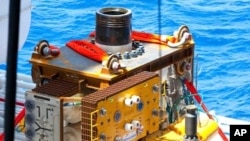After an initial delay, the oil company BP has started tests to see if a new containment cap will shut in the leaking Macondo deepwater oil well off the coast of Louisiana. If the effort works, the flow of noxious crude that has befouled the Gulf of Mexico since April would finally come to an end.
In a telephone briefing with reporters, BP Senior Vice President Kent Wells said the testing of the new cap had been delayed out of concerns that choking off the oil gusher could cause leaks elsewhere at the well bore or below the ocean floor. The test was to have started on Tuesday. Once government and BP scientists had checked seismic data and other information, Wells said, they decided to proceed cautiously with the tests.
"Over a couple hour period we will actually be choking back the flow, so there will still be some flow, but it is part of the test. Then, ultimately, when we choke off all the flow, that is the true shut-in test," he said.
Wells said BP is working closely with U.S. Department of Energy Secretary Steven Chu, government scientists and the US Coast Guard as the effort to shut in the leaking well continues, but he stressed that BP in charge of carrying out the task.
"BP is absolutely in control of this operation. It is our activity, we manage it. I have mentioned these consulting periods that we are going to have every six hours. During those, it will involve our BP scientists, the government scientists, Secretary Chu, his team, et cetera," he said.
This latest effort to stop the oil flow involves a 68,000 kilogram cap that BP engineers set on top of the well's damaged blow-out preventer over the past few days using remote-controlled undersea robots. Once the cap is fully secured and tested, BP officials say its vents will be slowly closed to see how it withstands the pressure of the oil and to check for any other areas where oil is leaking. If the integrity tests show no problems, engineers can then proceed with the closing of all three openings and funnel the oil flow to surface ships for processing.
This would, in effect, cap the well and eliminate the flow of petroleum that has created a huge contaminated area in the Gulf of Mexico and damaged coastal beaches and marshes. But company officials say they plan to proceed, nonetheless, with two relief wells that are being drilled from floating platforms on either side of the spill site.
One of those drilling operations is now within two meters of the intersection point with the leaking well's main shaft under the sea bed. But BP officials say that effort has been temporarily halted until testing of the containment cap is completed. Company officials say they are being extra cautious and trying to avoid any action that could create new leaks.
Oil has been flowing from the damaged well ever since the collapse of the Deepwater Horizon drilling rig on April 22, two days after an explosion that killed 11 workers. The area of surface water covered by the oil slick is over six thousand square kilometers in size and the US government has halted fishing operations along a wide area extending along the coast from western Louisiana to the Florida panhandle.
BP Begins Tests to Close Off Flow From Leaking Well
- By David Dyar







